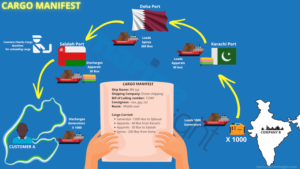By Hari Menon
A cargo manifest is a consolidated list of all the cargo that is on board a cargo vessel. The list of all cargo carried on the vessel will appear under the vessel name and identification marks of the vessel.

It would also show the route taken by the vessel. A manifest, in general, is a complete list of the cargo or passengers. Just like the cargo manifest, the passenger manifest lists details of all the passengers who are onboard a ship or airplane. This list would include details of the crew members as well.
Typically, a cargo manifest would list all the bills of ladings along with the above details and the total number of goods being transported shown per bill of lading. However, the individual bills of ladings will be attached to this cover sheet.
We can see how the cargo manifest works in this example given below.
Customer A in Djibouti buys 1000 gensets from company B in Kolkata, India. Company B ships these gensets by a cargo vessel. The vessel carries other electrical goods and consumer durables meant for customers en route and in Djibouti.
The cargo manifest of the ship will show the 1000 gensets purchased by customer A as well as the other electrical goods and consumer durables that are shipped on the vessel for the other customers.
Customs authorities at the respective ports will need to review and confirm the cargo manifest against the actual cargo being unloaded at these destinations.
As we can see in this example, the cargo manifest is a very important document for the shipment of goods without which goods cannot be unloaded at their destination ports or loaded from their load ports.
Typical Contents of a Cargo Manifest
Generally, the following details are shown in cargo manifests:
· Operator name and details
· Consignor information
· Document or Bill of Lading number
· Quantity, type, and description of goods
· Consignee information
· Shipping route
Who Uses the Cargo Manifest and Why?
While the cargo manifest is important to all concerned parties to the cargo carried on the ship, most importantly, it is the port customs who require the cargo manifest to allow the ship to unload its cargo on the port. It is usually the responsibility of the chief officer of the ship to submit the cargo manifest to the port customs.
Read Also: Up To 800,000 Seafarers Due For Carbon Upskilling By Mid-2030
Also called the first mate, the chief officer is in charge of the cargo that is onboard the vessel. The loading, unloading, stowage, and lashing of the cargo all come under the chief officer’s scope of responsibilities.
Answerable to the captain of the vessel, his duties may sometimes include the safety of the vessel and its sailors/passengers.
The typical cargo manifest lists all the goods that are on the ship though it may be meant for several different destinations.
The details that it contains include the item name, quantity and weight of the item, type of item, the name and address of the consignor, and the name and address of the consignee that each item is headed to at the destination port
In most cases, the cost of each item is also shown. The list is prepared according to the bills of ladings and the goods loaded from each port of call.
It is a convenient tick-list for the cargo vessel’s first mate or chief officer as each consignment is offloaded at their destination ports.
Kindly like us on Facebook/twitter















